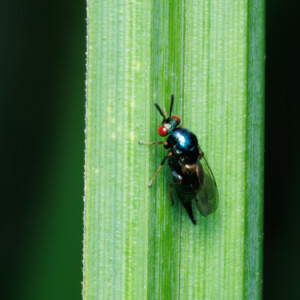Dangerous
How gorgeous is this? In fact, I even told her so at the time: "Oh, wow! You're gorgeous!" But I don't think she was listening, being far too intent on cantering up the sedge leaf to get away from me. The main image was the last photo I managed to take before she flew, but I've also included one of the first, showing her pretty much as I first saw her before our rather frantic pursuit began. That dorsal view gives a better sense of how compact and hunched she is, and the lovely contrast between her green and gold head and her crimson eyes, but it's the closer, lateral view that reveals the full splendour of her multicoloured and wildly decorated gastric tergites. She's only about 5mm long, by the way, but the male of the species is only half that length and generally less attractive - there's a photo of a male and several females at Naturespot, if you'd care to check the differences.
The parasitoid wasps are notoriously tricky to identify, but I'm pretty sure this one is Ormyrus nitidulus, which doesn't have a common name, but which parasitises the gall wasp Andricus quercuscalicis. Andricus quercuscalicis infests the acorns of English oaks, causing the nobbly deformity known as the knopper gall, and it's therefore sometimes referred to as the Knopper Gall Wasp. The Knopper Gall Wasp is an undistinguished little beast, hardly deserving of such a good common name, and I think the least we can do is refer to its fabulous attacker as the Knopper Gall Wasp Wasp.
It would have sealed the identification if I'd found my little wasp on a gall, but the wildlife pond lies just beyond the canopy of our huge English oak tree, which this year is covered with developing acorns and knopper galls, so she was definitely in the right territory. I haven't been able to find a precise description of the mechanism by which the Knopper Gall Wasp Wasp parasitises the Knopper Gall Wasp, but I expect that this female will be looking for galls in the early stage of development and laying her eggs in the chambers. Her larvae are described as ectoparasitoid, which means that they will develop on the outside of the host larvae, eventually killing them. This looks set to be a mast year, and there must be many hundreds - possibly thousands - of galls on our oak tree, so I hope to see many more of these beautiful wasps looking to take advantage of them before the end of summer.


Comments
Sign in or get an account to comment.


